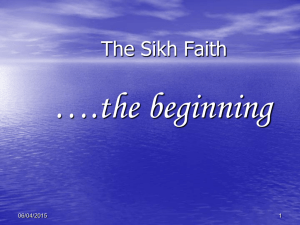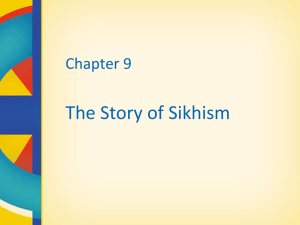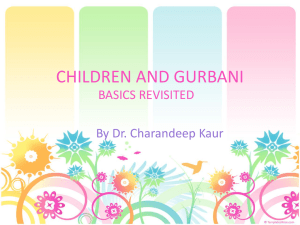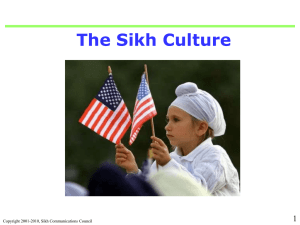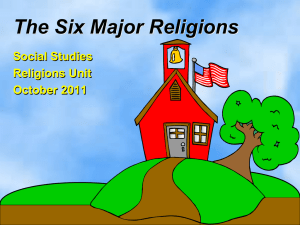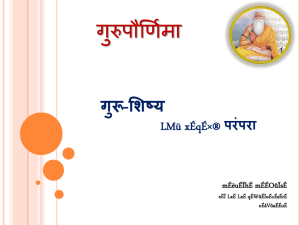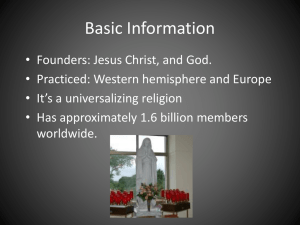The Life of Nanak
advertisement
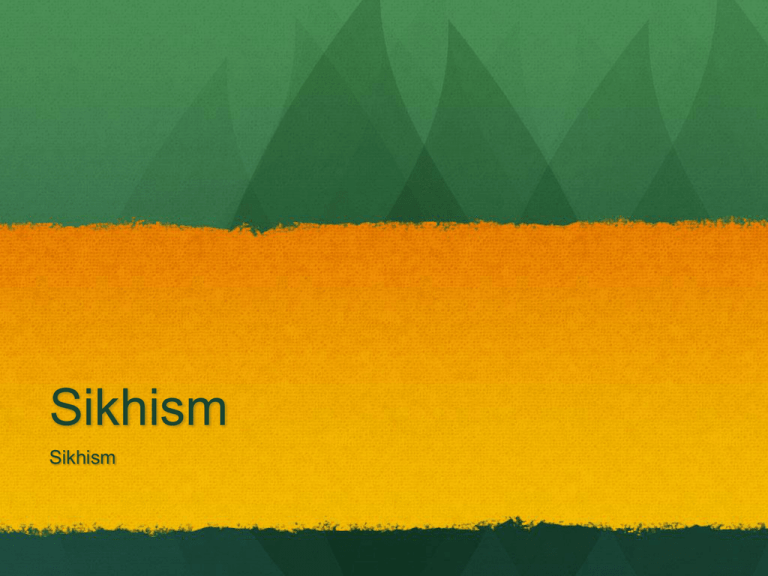
Sikhism Sikhism The Life of Nanak Starting in the tenth century, Muslims made inroads India Arrived in the northwest section of India was most frequently Here, Islam had the most Indian converts Because Islam and Hinduism were different in so many ways, there were ongoing conflicts between the faiths How were they different? The Life of Nanak Kabir (1440 – 1518 CE) is best known for bringing Hinduism and Islam together By worshipping with his Hindu neighbors, the Muslim Kabir taught that God is one The founder of Sikhism was Guru Nanak, who was born in the 1469 (in the line of 10 gurus through 1708) He was a dreamer and poet, who was distant from daily pursuits The Life of Nanak Nanak was more interested in religious and artistic pursuits than in business or practicality Nanak failed at the professions that he tried He eventually married and fathered two sons Always thought spiritual and family life were compatible Nanak eventually left his family and moved to Sultanpur to try his hand at business again The Life of Nanak When he was thirty, he went to bathe in a river when received a vision from God that changed his life God told Nanak that he was being singled out as a prophet of the true religion The message of the new religion was “There is no Muslim. There is no Hindu.”Emphasized unity and equality. Nanak began to wander as a preacher and wore mixed Hindu and Muslim clothes The Life of Nanak Wherever Nanak went he sought to form new Sikh communities Each of his followers became known as a Sikh, which is a Punjab word for “disciple” Traveled with Muslim musician to teach through music After many years of preaching, Nanak returned home to northwest India Once there, he preached and formed new Sikh communities The Life of Nanak According to legend, as Nanak was dying, each of his followers wanted to bury him according to his own religious tradition Nanak directed the men to bring flowers to his body and whoever had the freshest flowers the following day could bury him The next day, Nanak’s body was gone The message was that even in death Nanak sought to unify Hindus and Muslims His successors were the 1 of the 9 gurus The Life of Nanak The last guru – Guru Gobind Singh decided to end the line of gurus (1708) and bestow authority on the sacred text – Adi Granth It is the living guru of the sikhs Composed of guru teachings and Islam and Hindu holy texts Granthi – chanter of the text / place of worship is any place with text - Gurdwara The Teachings of Nanak Nanak sought to synthesize Islam and Hinduism by taking elements of both God is one, and followers call him “The True Name” The True Name is a creator of the universe and human beings are his supreme creation Because of their primacy as beings, humans can kill and eat animals Sikhs are among the few Indians who eat meat The Teachings of Nanak Nanak accepted the Hindu concept of reincarnation, as well as the concept of karma Nanak rejected the ceremonial practices of both Hindus and Muslims Instead, Nanak taught a plain and simple form of religion that distrusts ceremony and ritual The Teachings of Nanak Problem with humanity is self-centeredness Through inward devotion / meditation / reading of Granth one moves from self-centeredness to guru-centeredness Meditate on the name of God “The Timeless One” / Akal Purakh Or Vahiguru (“wondrous guru”) Three meanings of guru (the 10, the text, God) The Teachings of Nanak Pacifism Nanak taught pacifism, or nonviolence In all of his travels, he never struck out in violence, and he taught his disciples nonviolence as well Contrary to Nanak’s teachings, later Sikhs became known as the most militant of warriors The Historical Development of Sikhism After Nanak’s death, the Sikh movement was taken over by Angad They were the first two of a series of ten gurus who led the Sikhs until the eighteenth century While the term “guru” usually means teacher, to the Sikhs it means “leader” The fifth guru, Arjan Dev, is remembered for beginning the compilation of the Sikh Scriptures, the Adi Granth The Historical Development of Sikhism The Granth The Granth is a collection of hymns The majority of the hymns came from Nanak The remainder came from Kabir and other gurus It is roughly three times the size of the Rig-Veda and contain 3,384 hymns What does the Granth have in common with Hindu and Muslim texts? Divisions within Sikhism Modern Sikhs are mainly found in India There are three main divisions amongst its members: Udasis, Sahajdharis, and Singhs All three recognize the central teachings of Nanak, accept the Granth as sacred scripture, and accept the ten gurus as inspired leaders of the faith Divisions within Sikhism Udasis This is basically an order of holy men who follow principles similar to the Hindu, Jain, and Buddhist ascetics Sahajdharis This sect is conservative and seems to have stopped developing Singhs A corps of warriors started by Gobind Singh Divisions within Sikhism Singhs Arjan is recognized for giving the Sikhs the Granth but also a militant aspect in conflict with Nanak’s pacifism The last Sikh guru was Gobind Singh, who organized and prepared the Sikhs for self-defense and war He developed an elite fighting force, the Singhs (or lions) for that purpose Sikh Religious Life One joins the Sikhs by baptism instead of simply being born into the faith Daily rituals for Sikhs include an early-morning bath followed by the reading of certain hymns and the recitation of prayers There is also a nighttime ritual of hymns and prayers Sikh Religious Life Sikhs practice congregational worship in temples called gurdwaras The central object of worship is a copy of the scared Adi Granth There are no priests, so services are led by a member of the community There are also no caste or gender differentiations in worship Sikh Holy Days Because of its simplicity, Sikhism does not have an elaborate series of holidays In northern India, Sikhs celebrate Holi and Divali with their Hindu neighbors In June, Sikhs celebrate the martyrdom of Guru Arjan, the complier of the Granth Sikhs also celebrate the birthdays of Nanak and Arjan Sikhism Today Religion and Violence The lives of Sikhs have become more precarious in India as they become a minority group Sikhs lack the political strength of their Hindu and Muslim neighbors As a result, some radical factions of Sikhism are demanding that Punjab be declared an independent Sikh nation All of this has sometimes led to violent conflict Sikhism Today In recent years, Americans and Europeans have been attracted to Sikhism for its simplicity and tolerance, as well as for its emphasis on the equality of men and women Because Indians living a Western life are sometimes living in a more worldly fashion, there can be conflicts between faith and lifestyle Sikhism began as an attempt to unify Hinduism and Islam. What makes this attempt inherently problematic? Is it more productive or counterproductive to seek unity between religions by inventing a third, different religion? End
